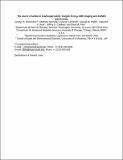The source of sulfate in brachiopod calcite : insights from μ-XRF imaging and XANES spectroscopy
Abstract
Geochemical signatures preserved in sedimentary carbonate strata are often used as archives for paleoenvironmental reconstructions. However, diagenetic overprinting and/or muting of primary geochemical signatures complicates the interpretation of these data. To avoid this issue, geochemical techniques strive to target unaltered (or minimally altered) carbonate components. The multi-layer low-Mg calcite shell composition of articulate brachiopods are often the target in such studies because they are commonly more robust to recrystallization than the shells of other biomineralizers. Here, we have combined S K-edge μ-XRF imaging, XANES spectroscopy and petrography to determine the source of sulfate in the calcite lattice (carbonate-associated sulfate; CAS) of ancient and extant brachiopods, in order to establish their suitability for use in reconstructing seawater sulfate δ34S throughout the Phanerozoic. Both the extant brachiopod Terebratalia transversa and fossil brachiopods display intra-specimen variability in sulfate abundance parallel to the primary fabric, likely corresponding to variations in growth rate. XANES spectroscopy identifies a majority of the sulfate as inorganic. Additionally, XANES spectroscopy detected low abundances of both reduced and oxidized organic sulfur species (thiol, thioether, sulfoxide and sulfate esters) in all T. transversa samples and lesser abundances in a few of the fossil brachiopods. In T. transversa, inorganic sulfate and sulfate ester abundance increase towards the hinge of the valves. Bulk δ34SCAS of the samples containing the fossil brachiopods are consistently more positive than time-equivalent brachiopod-only values, likely reflecting a mixture of CAS signals from homogenization of carbonate components differentially affected by depositional environment and diagenesis. In contrast, bulk δ34SCAS of modern T. transversa is approximately 1‰ more positive than coeval seawater. Although organic sulfate esters are found within the brachiopod shells, they are only ever present as trace components. Our findings indicate that the vast majority of sulfate in brachiopod shells is inorganic, sourced from coeval seawater. This result supports the use of brachiopods as a potential archive for a faithful CAS record of seawater sulfate throughout the Phanerozoic. The characterization of in situ organic sulfur compounds in both extant and fossil brachiopods indicates the potential importance of various organic sulfur compounds in mineralogical determination (and therefore fossil preservation) and crystal orientation during brachiopod biomineralization throughout geologic time.
Citation
Richardson , J A , Newville , M , Lanzirotti , A , Webb , S M , Rose , C V , Catalano , J G & Fike , D A 2019 , ' The source of sulfate in brachiopod calcite : insights from μ-XRF imaging and XANES spectroscopy ' , Chemical Geology , vol. 529 , 119328 . https://doi.org/10.1016/j.chemgeo.2019.119328
Publication
Chemical Geology
Status
Peer reviewed
ISSN
0009-2541Type
Journal article
Description
Acknowledgment is made to the donors of the American Chemical Society Petroleum Research Fund (#57548-ND2) for partial support of this research. Use of the Stanford Synchrotron Radiation Lightsource, SLAC National Accelerator Laboratory, is supported by the U.S. Department of Energy, Office of Science, Office of Basic Energy Sciences under Contract No. DE-AC02-76SF00515. The SSRL Structural Molecular Biology Program is supported by the DOE Office of Biological and Environmental Research, and by the National Institutes of Health, National Institute of General Medical Sciences (including P41GM103393).Collections
Items in the St Andrews Research Repository are protected by copyright, with all rights reserved, unless otherwise indicated.

